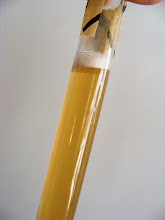
Notice the starter on the stir plate is nice and cloudy vs the counter top beaker which has a clear wort with only a small colony propagating on the bottom.
After removing the Erlenmeyer flask from the stir plate and allowing the yeast to settle the difference is quite noticeable. Look at the nice layer of yeast cells in the Erlenmeyer vs the small colony in the beaker.
I don't have a microscope at home to do yeast counts but there is visibly more yeast in my starter on the stir plate. I have a second stir plate I built sitting in the basement with a loose connection. I really need to get that one back in operation so I can run multiple stir plates at the same time.
One of the things that has been keeping me busy is brewing gadget product. I've begun to get interested in open fermentation and have been thinking about giving it a try. I've always thought Yorkshire Square ferementers were pretty cool and I decided to build my own mini (or perhaps nano) Yorkshire Square.
 There is a large cache of old slate pavers at my parents house that used to make up a walk to their front door (about 20 years ago). These stones have been patiently waiting to be put to good use for quite some time now and conveniently are about the size I needed for this project. So 5 slabs of slate, an inexpensive tile saw purchased on Craig's List, some food grade silicone, and some scrap poplar that was lying around and before you know it I have a new 6.5 gal fermenter.
There is a large cache of old slate pavers at my parents house that used to make up a walk to their front door (about 20 years ago). These stones have been patiently waiting to be put to good use for quite some time now and conveniently are about the size I needed for this project. So 5 slabs of slate, an inexpensive tile saw purchased on Craig's List, some food grade silicone, and some scrap poplar that was lying around and before you know it I have a new 6.5 gal fermenter.Weighing in over 50 pounds empty it may not be the most practical piece of brewing equipment but it sure is nice to look at. I have a starter of Burton Ale yeast brewing up to be used in my first batch in the fermenter. Given the number of small cracks and crevices in the stone I assume it will never be sanitized the way a glass carboy can. I am planning to pitch a very large starter to the first batch hoping to innoculate all these small places where microbes might hide. I've picked the Burton Ale yeast for it's flavor profile as well as its reputation as a good top cropper, a trait which seems important in an open fermentation. The wort for this first fermentation will be from a split batch with the other batches being closed. It should be interesting to see what sort of differences (if any) there are between fermenter types.





